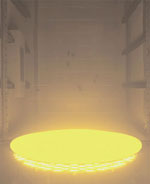
What's involved, of course, is the fear that people are the butt of some great big joke. I think that's one of the themes of that play Art, which ran forever in the West End and I didn't see because I'm a big snob. But I'm also a very lazy one, physically and intellectually, which is how I know that this fear of contemporary art is unfounded. Because I hate any form of entertainment that requires me to make an effort (I'd say I'd run a mile from it, but I'm not about to do any running), and I dig contemporary art.
Take the current showpiece event in London, Olafur Eliasson's Weather Project at Tate Modern (better known as 'that big sun' thing.)
The Guardian describes it as a 'witty, beautiful and ecologically questionable mediation on the environment of 21st-century Earth.'
What it is is a huge half-circle of yellowish light, mirrors covering the entire ceiling of the Tate's massive turbine hall and some dry ice. What it looks like is a hazy sun setting (or rising) in the gallery itself. What it does is to turn the Tate into some bizarre hippy festival, with dozens of people lying on the floor and wriggling around, looking at their reflections while the whole place is tinted fuzzy amber. I was expecting the Grateful Dead to start playing at any minute.
In some ways, I think it's most effective when you aren't looking at the piece at all: wandering around the upper floors, you suddenly catch a glimpse of the windows to the hall and realise that the whole inside of the building is glowing yellow.
But as for what it means, if it means anything, I'm stumped. Is it 'witty'? I don't think so, but I'm wary of wit anyway, because it conjures up bad Oscar Wilde productions or the odious Steely Dan. Does it make me think about the climate change? Or perhaps the death of God, as the Independent on Sunday suggests?* Not for a moment. But it is both disappointing - it's not as overwhelming as I wanted it to be - and pleasing all at once.
More explicitly entertaining conceptual art upstairs at the Tate in Common Wealth, a group show by Jennifer Allora & Guillermo Calzadilla, Thomas Hirschhorn, Gabriel Orozco and Carsten Holler. They say it's about playfulness, and so it is: there's a table tennis table (by Orozco) with four rounded ends and a lily pond in the middle and the punters enjoy trying to play in what are impossible circumstances.There's a series of mirrored automatic sliding doors (Holler) that you drift through and find your image reflected hundreds of times in several directions. And there a replica of the of the International Space Station made from coat hangers (Allora & Calzadilla) that tries to pick up radio signals from the ISS itself. It's a funfair for the gallery-loafing classes, and that's no bad thing.
There's a room made of cardboard and gaffer tape filled with Epstein sculptures (Hirschhorn) covered with photocopied bits of art history and bookshelves of Nietzsche and Heidegger. And that really has to mean something, although again I don't have a clue what it is. But I enjoyed it. Contemporary art: it can make you feel like you are in a particularly deranged episode of The Avengers.
So I'm thinking the sticking point isn't the art, it's social comfort: I've absorbed a bit of art history and can, if absolutely necessary, go 'blah Fluxus... blah Duchamp... blah Art & Language' and that gives me the confidence to crash around a gallery relying on my ill-considered reactions. Maybe. Anyway, more intended fun at The Approach, over a pub out in Bethnal Green, where they were showing Dave Muller's paintings of the spines of his record collection. Unfortunately, you can earn yourself a piece of Dave's art by bringing in one of your favourite records, and what was playing as I got there was Dark Side of the Moon. As an experiment with my reactions, it proved I can endure around two and a half minutes of the Floyd before having to run screaming into the streets of the East End. Which brings me back to the point, really: how can anyone work up fear or hatred for Damien Hirst or poor old Rachel Whiteread when Roger Waters is still a free man?
*Unlike The Truman Show, which everyone seemed to treat as a canny media satire when I was sure it all too obvious was an exploration of the Death of God, and a rather tedious one at that.
© 2003Mark Morris